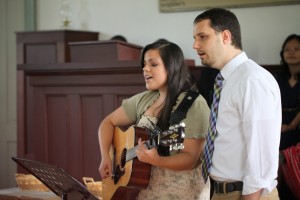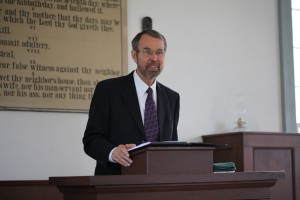As the Seventh-day Adventist church grows and becomes more diverse and distant from the culture and language at its beginning, a challenge has arisen in teaching an understanding of the church’s unique identity. There is a lack of knowledge of Adventist identity both within and without the Seventh-day Adventist church. Members everywhere ask “What makes us unique as a church?” Twelve years ago, in 2002, then Seminary student Michael Campbell, facilitated the first Seminary Heritage Sabbath at the Historic Village in Battle Creek, Michigan. The 13th annual Seminary Heritage Sabbath was held this year on September 6 at the Historic Adventist Village in Battle Creek, Michigan. Set near the beginning of the school year, the special day is intended to be a foundational event for students in their year at the seminary.
A large part of our Adventist theological identity can be found in the Great Controversy theme. There is a war that is being fought between Satan and his angels and Christ and his angels. In the humble home of James and Ellen White on Wood Street in the Historic Adventist Village, Ellen White began writing on this theme. The White home can function as a mnemonic “hook” to anchor the Great Controversy theme in the mind.
The Whites first moved to Battle Creek in 1855. They built their home in 1856 and it was the only place where the entire family, with all four boys lived together. John Herbert died in infancy and Henry died at the age of 16. Not until the Second Coming and the resurrection will they all be together again. The boys’ bedroom is found on the main floor with one wide bed for the older two sons, Henry and Edson, and a trundle bed for little Willie. On the second floor is a room with a writing desk and a rocking chair. Ellen White would often awaken in the early hours of the morning and write for some time. At the breakfast table she would share some of what she had been writing that morning.

For this fall’s Heritage Sabbath Mariesa and Matthew Tinkham gave a special music entitled “In the Sanctuary.” The lyrics of this song enunciate our distinct Seventh-day Adventist belief in the role of Jesus as our High Priest in the heavenly sanctuary. “He’s our Defender before the Father . . . investigating, He clears the record of those redeemed by His own blood.”
Dr. Richard M. Davidson spoke for the morning worship service. He holds the title of J. N. Andrews, Professor of Old Testament Interpretation, at the Seventh-day Adventist Theological Seminary. The title of his sermon was “The Sanctuary Message—So What?” He introduced his sermon with an overview of the pioneers’ understanding of the sanctuary message and how it affected their sense of mission. Then he spoke about how the second-generation pioneers understood the sanctuary. Next he shared his personal testimony about his own growth in understanding the sanctuary including living through the Ford Crisis of the 1980s. Then he gave a Biblical exposition asking various Bible characters what they thought of the Most Holy Place ministry of Jesus and the investigative judgment. Davidson pointed out the chiastic structure of the Pentateuch with chapter 16 of Leviticus as the center, which he explained as essential to understanding the meaning of the Books of Moses. Leviticus 16 discusses the Day of Atonement, which was the climax of the Sanctuary service in the Jewish calendar year. Yom Kippur, the Day of Atonement, occurs right after Rosh Hashanah at the beginning of the Jewish New Year which is usually in September and followed by the festival of tabernacles. Under the first covenant the Day of Atonement was the day when the temple was cleansed of sin through the blood of a sin offering. With the death of Jesus the first covenant ended, and Jesus became our sin offering under the New Covenant.
In reflecting on Dr. Davidson’s sermon, Samuel Pagán De Jesús, PhD student in Adventist Studies, said: “Dr. Richard Davidson’s message was inspiring. It sought to answer the question: “Why the sanctuary?” And through the historical testimonies of the pioneers and his own personal testimony, together with his biblical understanding and explanations, he reaffirmed the faith of visiting students, not only on the importance of the sanctuary message for Adventists, but of more importance, the relevance of this for today’s world. In light of suffering humanity, he challenged us to look into the sanctuary where Jesus as our High Priest is working for our salvation.”
Dr. Merlin Burt told stories in the Oak Hill Cemetery (with the date 1844 written in wrought iron above its gates). There are hundreds of names that are familiar to Seventh-day Adventists written on the memorial stones of that cemetery. The stories of the men and women buried there could fill several volumes. On the cemetery tour during Seminary Heritage Sabbath, a few of these stories were highlighted. Located in this cemetery are the graves of the White family; John Byington, the first president of the General Conference; C. W. Post; Sojourner Truth; Goodloe Bell, founding professor of Battle Creek College; Uriah Smith; and many others.
Many of the attendees at Seminary Heritage Sabbath have been pastors or soon will be. As such, many related best to the story told of Uriah Smith, who was editor of the Review and Herald for nearly 50 years. Smith was the “pastor” for many nineteenth-century readers scattered far from other believers and without a local congregation with which to meet. His nine-year sojourn in a spiritual wilderness while still holding the office of editor was a comfort and charge to those in the pastoral ministry. To hear this story, come next year on the tour of the cemetery.
Seminary Heritage Sabbath is an annual event for students of the Seventh-day Adventist Theological Seminary at Andrews University. This day is a way for Seminary students and their families to connect with the spiritual and theological roots of the Seventh-day Adventist church. John McVay, former dean of the Seminary said this: “As we grow chronologically distant from those early chapters of our story, we must be intentional about connecting with our own saga. We dare not become emotionally or spiritually estranged from our pioneers and their zeal for the Second Coming of Jesus.”

